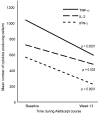Alefacept (anti-CD2) causes a selective reduction in circulating effector memory T cells (Tem) and relative preservation of central memory T cells (Tcm) in psoriasis
- PMID: 17555598
- PMCID: PMC1906741
- DOI: 10.1186/1479-5876-5-27
Alefacept (anti-CD2) causes a selective reduction in circulating effector memory T cells (Tem) and relative preservation of central memory T cells (Tcm) in psoriasis
Abstract
Background: Alefacept (anti-CD2) biological therapy selectively targets effector memory T cells (Tem) in psoriasis vulgaris, a model Type 1 autoimmune disease.
Methods: Circulating leukocytes were phenotyped in patients receiving alefacept for moderate to severe psoriasis.
Results: In all patients, this treatment caused a preferential decrease in effector memory T cells (CCR7- CD45RA-) (mean 63% reduction) for both CD4+ and CD8+ Tem, while central memory T cells (Tcm) (CCR7+CD45RA-) were less affected, and naïve T cells (CCR7+CD45RA+) were relatively spared. Circulating CD8+ effector T cells and Type 1 T cells (IFN-gamma-producing) were also significantly reduced.
Conclusion: Alefacept causes a selective reduction in circulating effector memory T cells (Tem) and relative preservation of central memory T cells (Tcm) in psoriasis.
Figures


Similar articles
-
Changes in circulating lymphocyte subpopulations following administration of the leucocyte function-associated antigen-3 (LFA-3)/IgG1 fusion protein alefacept.Clin Exp Immunol. 2007 Jul;149(1):23-30. doi: 10.1111/j.1365-2249.2007.03380.x. Epub 2007 Apr 2. Clin Exp Immunol. 2007. PMID: 17403057 Free PMC article.
-
Treatment of chronic plaque psoriasis by selective targeting of memory effector T lymphocytes.N Engl J Med. 2001 Jul 26;345(4):248-55. doi: 10.1056/NEJM200107263450403. N Engl J Med. 2001. PMID: 11474662 Clinical Trial.
-
The effect of topical corticosteroids in combination with alefacept on circulating T-cell subsets in psoriasis.J Dermatolog Treat. 2007;18(5):279-85. doi: 10.1080/09546630701395044. J Dermatolog Treat. 2007. PMID: 17852631 Clinical Trial.
-
Selective targeting of T cell subsets: focus on alefacept - a remittive therapy for psoriasis.Expert Opin Biol Ther. 2002 Apr;2(4):431-41. doi: 10.1517/14712598.2.4.431. Expert Opin Biol Ther. 2002. PMID: 11955280 Review.
-
Possibilities of using alefacept in the treatment of psoriasis.Ann Univ Mariae Curie Sklodowska Med. 2003;58(2):311-3. Ann Univ Mariae Curie Sklodowska Med. 2003. PMID: 15323211 Review.
Cited by
-
CD58 Immunobiology at a Glance.Front Immunol. 2021 Jun 8;12:705260. doi: 10.3389/fimmu.2021.705260. eCollection 2021. Front Immunol. 2021. PMID: 34168659 Free PMC article. Review.
-
Inducing and Administering Tregs to Treat Human Disease.Front Immunol. 2016 Jan 22;6:654. doi: 10.3389/fimmu.2015.00654. eCollection 2015. Front Immunol. 2016. PMID: 26834735 Free PMC article. Review.
-
Transcriptome-Based Molecular Networks Uncovered Interplay Between Druggable Genes of CD8+ T Cells and Changes in Immune Cell Landscape in Patients With Pulmonary Tuberculosis.Front Med (Lausanne). 2022 Feb 7;8:812857. doi: 10.3389/fmed.2021.812857. eCollection 2021. Front Med (Lausanne). 2022. PMID: 35198572 Free PMC article.
-
Putting together the psoriasis puzzle: an update on developing targeted therapies.Dis Model Mech. 2012 Jul;5(4):423-33. doi: 10.1242/dmm.009092. Dis Model Mech. 2012. PMID: 22730473 Free PMC article. Review.
-
In vivo depletion of lymphotoxin-alpha expressing lymphocytes inhibits xenogeneic graft-versus-host-disease.PLoS One. 2012;7(3):e33106. doi: 10.1371/journal.pone.0033106. Epub 2012 Mar 12. PLoS One. 2012. PMID: 22427961 Free PMC article.
References
-
- Austin LM, Ozawa M, Kikuchi T, Walters IB, Krueger JG. The majority of epidermal T cells in Psoriasis vulgaris lesions can produce type 1 cytokines, interferon-gamma, interleukin-2, and tumor necrosis factor-alpha, defining TC1 (cytotoxic T lymphocyte) and TH1 effector populations: a type 1 differentiation bias is also measured in circulating blood T cells in psoriatic patients. J Invest Dermatol. 1999;113:752–759. doi: 10.1046/j.1523-1747.1999.00749.x. - DOI - PubMed
Publication types
MeSH terms
Substances
Grants and funding
LinkOut - more resources
Full Text Sources
Other Literature Sources
Medical
Research Materials

